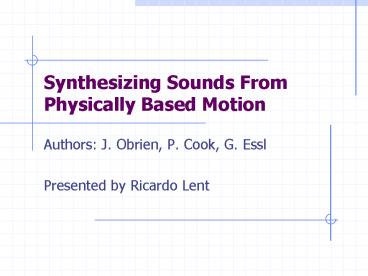Synthesizing Sounds From Physically Based Motion PowerPoint PPT Presentation
1 / 30
Title: Synthesizing Sounds From Physically Based Motion
1
Synthesizing Sounds From Physically Based Motion
- Authors J. Obrien, P. Cook, G. Essl
- Presented by Ricardo Lent
2
References
- Synthesizing Sounds from Physically based motion.
J. OBrien et al. ACM SIGGRAPH 2001 - Animating Fracture. O'Brien, J. F., Hodgins, J.
K., Communications of the ACM, July 2000, Vol.
43, No. 7, pp. 68-75. - Graphical Modeling and Animation of Fracture.
Ph.D. Thesis J. OBrien (Chapter 3), GIT. August
2000
3
Sound Modeling
- Acoustic waves (longitudinal waves)
20-20K Hz
Moderate intensity
4
Paper Idea
- Approximate sounds generated by the motions of
solid objects. - Based on previous work in animation using
deformable objects.
5
Sound Generation
- Analyze motion and surfaces.
- Determine how the motion will induce acoustic
pressure waves in the surrounding medium. - Computes propagation of waves to the listener to
generate sounds corresponding the objects.
6
1. Motion of Solid Objects
- Basic criteria
- Temporal resolution 20 - 20Khz (approx. time step
10e-5 sec) - Dynamic deformation modeling (elastic
deformation) in addition to rigid body motion - Explicit representation of the objects surfaces
- Physical Realism
7
Physically Based Modeling and Fractures
- Numerical simulations of physical systems to
generate synthetic motion of virtual objects - Model for object deformation
8
Continuous Model
- Describe behavior of material as it deforms
(based on continuum mechanics approach) - System determines fractures
9
Material World Coordinates
10
Continuous Model
- Strain measures total local deformation of the
material - Greens strain tensor (invariant to rigid body
transformations)
Strain tensor
Strain rate tensor
11
Strain Tensors
- Strain strain rate tensors provide information
about internal elastic and damping forces. - Tensors are invariant to rigid body
transformations and orientation of material. - They do not account for properties of the
material.
12
Stress Tensor
- Stress tensor combines strain and strain rate
with material properties (elastic) - Material isotropic
rigidity
resistance to changes
Elastic relationship
Damping properties
Kinetic energy dissipation rate
13
Traction _at_ any point
14
Mapping
- Finite element method to map an object from some
reference state to its deformed configuration - Mapping uses tesselating tetrahedral elements
15
Tesselating
16
Finite Approximation
- Tetrahedral 4 nodes (position in material and
world coordinates, and velocity - Continuous functions for strain, strain rate and
stress are described at the nodes - These forces determine the accelerations, and the
motion of the deformable object
17
2. Surface Vibrations
- Pressure for ds of ?
18
Discretization
- Approximate pressure field as being constant over
each triangle in ?
Pressure fluctuation
19
Removing Aliasing Artifacts
- Low-pass filter
- DC-blocking filter
20
Digital LP Filter
21
Windowing
22
3. Wave Radiation and Propagation
- Pressure wave from ? sum results of many simple
waves (Huygens principle) - Pressure wave from a single triangle
- Spherical wave - No reflection/diffraction
23
Delay
- Sound speed ltlt light speed
- Doppler shifting
- Stereo sound using multiple receivers
- Delay is computed in addition to s and stored
24
Examples
25
Clamped Bar
26
Square Plate
27
Spectrogram for Plate
28
Real vs. simulated vibraphone
29
Swinging Bar
30
Final Comments
- Time step may be too small for fast rendering
- Rigid body simulations are excluded for sound
generation - Reflected and diffracted sound is not considered
- Listener is omni-directional
- Model is also useful for debugging

